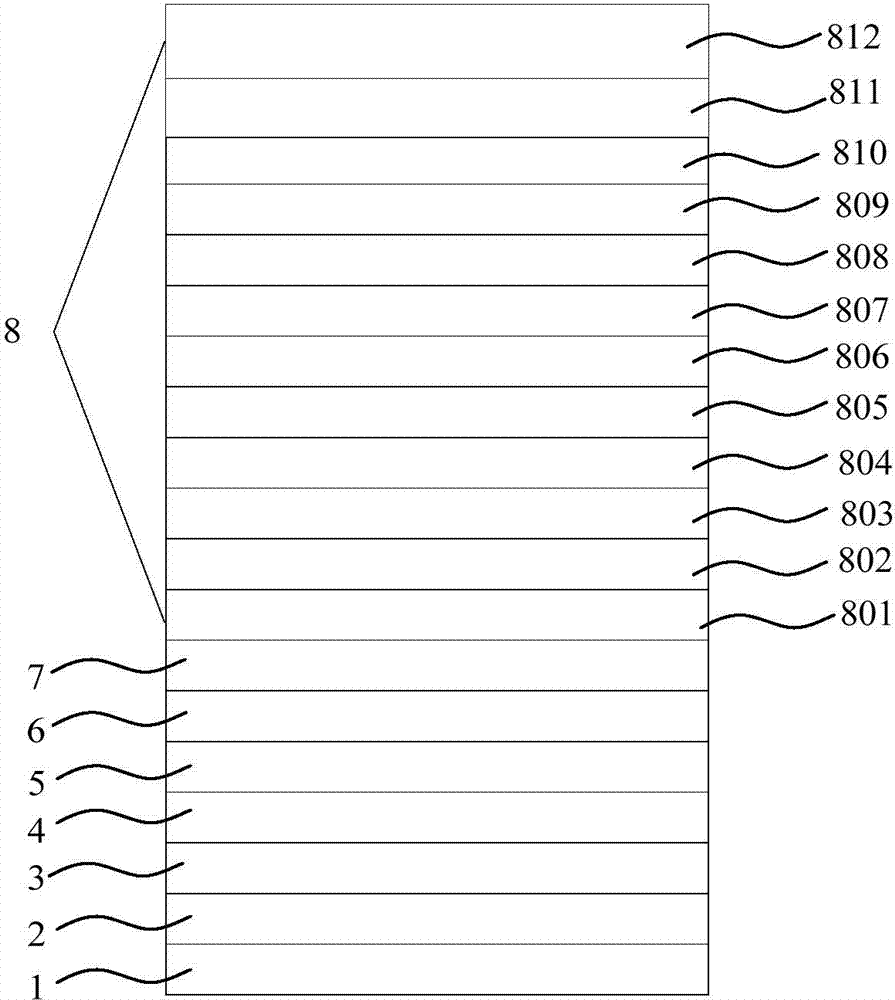Organic light emitting diode device and preparation method thereof
An electroluminescent device, organic technology, applied in the direction of electric solid state device, semiconductor/solid state device manufacturing, electrical components, etc.
- Summary
- Abstract
- Description
- Claims
- Application Information
AI Technical Summary
Problems solved by technology
Method used
Image
Examples
Embodiment 1
[0062] A method for preparing an organic electroluminescent device, comprising the following steps:
[0063] (1) Pre-treatment of ITO conductive glass substrate 1: put ITO conductive glass substrate 1 into acetone, ethanol, deionized water, and ethanol in sequence, ultrasonically clean them for 5 minutes, then blow dry with nitrogen, and dry them in an oven for later use; The cleaned ITO glass substrate 1 is subjected to surface activation treatment to increase the oxygen content of the conductive surface layer and improve the work function of the conductive layer surface; the thickness of the ITO glass substrate 1 is 100nm;
[0064] Hole injection layer 2: Evaporate MoO on the ITO conductive glass substrate 1 3 Hybrid material obtained by doping NPB, MoO 3 The doping mass fraction in NPB is 30%, and the evaporation is carried out by high-vacuum coating equipment, and the vacuum degree during evaporation is 1×10 -5 Pa, the evaporation rate is A hole injection layer 2 is ob...
Embodiment 2
[0082] A method for preparing an organic electroluminescent device, comprising the following steps:
[0083] Step (1) is the same as embodiment 1;
[0084] (2) Place the organic electroluminescent device sample in a vacuum coating machine, and prepare a mixed barrier layer by vacuum evaporation on the organic electroluminescent device sample. The material of the mixed barrier layer is ZnPc, NPB, CeF 2 and V 2 o 5 Formed hybrid materials, ZnPc, CeF 2 and V 2 o 5 The mole fractions of the mixed materials are 40%, 15% and 10%, respectively, and the evaporation vacuum is 5×10 -5 Pa, the evaporation rate of ZnPc is The thickness of the mixed barrier layer is 150nm;
[0085] (3) The inorganic barrier layer was prepared by atomic layer deposition on the mixed barrier layer, and the material of the inorganic barrier layer was ZrO 2 ;
[0086] A preparation cycle for preparing an inorganic barrier layer is:
[0087] (a) [Zr(N(CH 3 ) 2 ) 4 ] is injected into the deposition...
Embodiment 3
[0095] A method for preparing an organic electroluminescent device, comprising the following steps:
[0096] Step (1) is the same as embodiment 1;
[0097] (2) Place the organic electroluminescent device sample in a vacuum coating machine, and prepare a mixed barrier layer by vacuum evaporation on the organic electroluminescent device sample. The material of the mixed barrier layer is FePc, Alq3, MgF 2 and WO 3 Formed hybrid materials, FePc, Alq3 and WO 3 The mole fractions of the mixed materials are 60%, 10% and 20% respectively, and the evaporation vacuum is 5×10 -5 Pa, the evaporation rate of FePc is The thickness of the mixed barrier layer is 100nm;
[0098] (3) The inorganic barrier layer was prepared by atomic layer deposition on the mixed barrier layer, and the material of the inorganic barrier layer was HfO 2 ;
[0099] A preparation cycle for preparing an inorganic barrier layer is:
[0100] (a) [Hf(N(CH 3 ) 2 ) 4 ] is injected into the deposition chamber of ...
PUM
| Property | Measurement | Unit |
|---|---|---|
| Thickness | aaaaa | aaaaa |
| Thickness | aaaaa | aaaaa |
| Thickness | aaaaa | aaaaa |
Abstract
Description
Claims
Application Information
 Login to View More
Login to View More - R&D
- Intellectual Property
- Life Sciences
- Materials
- Tech Scout
- Unparalleled Data Quality
- Higher Quality Content
- 60% Fewer Hallucinations
Browse by: Latest US Patents, China's latest patents, Technical Efficacy Thesaurus, Application Domain, Technology Topic, Popular Technical Reports.
© 2025 PatSnap. All rights reserved.Legal|Privacy policy|Modern Slavery Act Transparency Statement|Sitemap|About US| Contact US: help@patsnap.com



